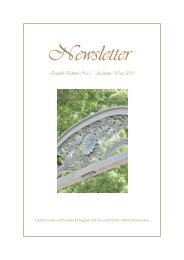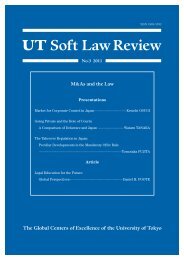UT Soft Law Review
UT Soft Law Review
UT Soft Law Review
You also want an ePaper? Increase the reach of your titles
YUMPU automatically turns print PDFs into web optimized ePapers that Google loves.
<strong>UT</strong> <strong>Soft</strong> <strong>Law</strong> <strong>Review</strong> No.2 2010process and price. 23Neither standard was particularly well-suited or responsive to the concerns presented byhostile takeovers, because (1) board resistance to hostile takeovers, particularly tender offers,did not comfortably fit the paradigms envisioned by those two standards and (2) applicationof these standards to hostile takeovers created the risk of being either under or over-inclusive.Here is why.The business judgment standard presupposes that the board has made a “businessjudgment” that involves the business or assets of the corporation. But, as earlier noted, atender offer is (formally speaking) a transaction solely between the offeror and the targetcompany stockholders. Under the DGCL a tender offer does not require the board’s approval,and arguably does not involve the corporation’s “business” at all. Nor was the entire fairnessstandard a good fit for the hostile takeover fact pattern. That standard was applied totransactions that involved self dealing by a majority stockholder or that was approved by aboard having a financial conflict of interest. But, many corporate boards that approveddefensive measures against hostile tender offers had a majority of independent directorswhose livelihoods (unlike those of “inside” directors) would not be affected by the outcome ofthe hostile offer. In such cases, no self-dealing in the classic sense was involved at all.Moreover, these two standards, if applied to review board anti-takeover defensive behavior,created a risk of either over or under inclusion. <strong>Review</strong>ing a takeover defense under theentire fairness standard created a significant risk of over-inclusion, i.e., that the defensewould be invalidated simply because the defensive measure would deprive the shareholdersof the ability to accept an offer at a premium above the market price of the target companystock. Thus, fairness review would create a high risk of depriving target boards of their abilityto protect shareholders against coercive, two-tiered offers of the kind involved in Unocal. Onthe other hand, reviewing a takeover defense under the business judgment standard wouldvirtually guarantee its validation, thereby creating the risk of under-inclusion. That is,business judgment review created a risk that courts would give undue deference to defensivedecisions by a compliant board that, even though disinterested and acting in good faith, wasservile to the views of senior managers who did have a career-based self-interest in opposingan offer that would benefit the shareholders.Accordingly, for almost two decades the Delaware courts embarked on a quest for a reviewstandard that would better address the complexities of hostile takeovers and the variedmotives that drive a target board’s defensive responses. That quest eventually led theDelaware Supreme Court to formulate entirely new review standards. I refer, of course, tothe so-called “intermediate” standards that the Supreme Court adopted and articulated inUnocal and Revlon in 1985, and that the Court of Chancery adopted in Blasius in 1988. 24At this point I discuss the Delaware intermediate review standards, for two reasons. First,they are substantively relevant to Japan, if only because the CVSG and the Guidelines adoptedsome aspects of them in whole or in part. Second, those review standards may be23 Weinberger v. UOP, Inc., 457 A.2d 701, 711 (Del. 1983).24 Blasius Indus. v. Atlas Corp., 564 A.2d 651, (Del. Ch. 1988).18





